Lauren Cartwright’s Missouri Paddock Paradise
April 30, 2006
My Paddock Paradise in central Missouri
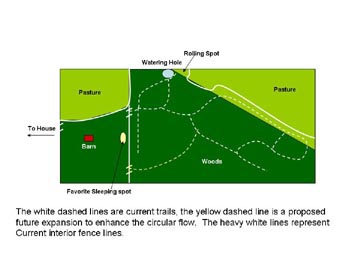
Some basic stats:
21 acres, approximately 12 acres accessible to horses
Mostly hardwood forest
About 4 acres pasture
Home to 4 horses
I have always kept my horses barefoot except for short periods here and there. They had never had a real barefoot trim however until I started trimming them about 3 years ago. It has been a learning curve. All four horses are very easy keepers and I have always had to restrict their grass intake during the growing season. The problem was that while I had them off grass in a dry lot they were bored and my mare would get very grumpy.


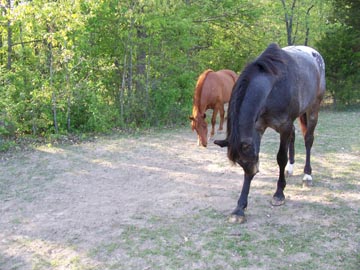
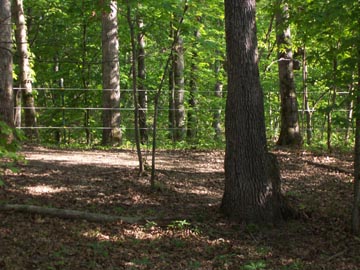
The Paddock Paradise ideas have given me a way to be able to restrict their grass intake while also allowing them ample recreation and movement. I am sure I will see improvements in their muscle development and hooves over time. I have already seen a dramatic improvement in their attitude.


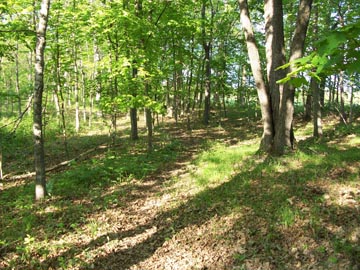
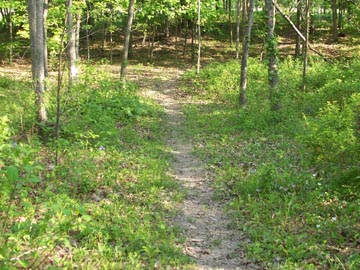
I am relatively lucky because my property has lots of topography relative to this area in general. When we first moved into the property I fenced off about 1 acre around the barn to serve as the dry lot and restricted them from the rest of the property that included much more acres of woods and pasture. As a result of the Paddock Paradise concept I have now instead just fenced off the pasture and opened up access to all the wooded acres, which includes a great little frog pond and lots of trails that were already present. The horses have also started to make a few new trails as they wander and get more familiar with their new environment.


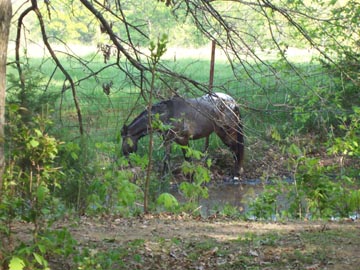
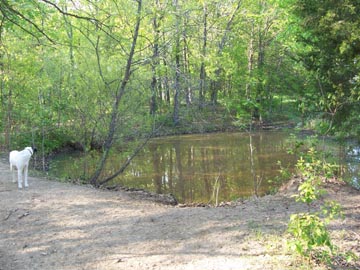
At this time I do not have the trails in the wood fenced. I am waiting to see what their patterns are to see if this will be necessary. There is one large section of woods that there are no trails through at this time. I plan on making a new spur trail to tie into the barn paddock this winter. I have also started to gravel portions of the paths. I hope to continue this over time so most of them are graveled for foot conditioning.


I will keep this information updated and the experiment continues.
About Griton (One Who Shouts)
April 28, 2006
Griton (gree-tone') was born in 2000 and is a BLM mustang gelding from the Stewart Creek HMA in Wyoming. He is about 15.1HH tall, looks like he has draft blood, and is a minimally expressed curly coated mustang. He is the only one of our mustangs we purchased rather than adopted. He is also the only one of our mustangs that has ever worn shoes.
The photo below was taken in March of 2005 right after we bought him and I wish I had been clairvoyant enough to have taken photos of his hooves then! At the time of this photo, his feet were quite contracted from shoes and a very bad case of thrush. His front feet had the shape of a three-leaf clover with points in the front and flares at the quarters.

Just three months after we bought him, Griton injured both stifles by kicking out in play and hanging his back legs over a fence. Many people suggested surgery and/or prolonged stall rest but we chose to give him a chance to rehabilitate himself.
Since the usual therapy for loose or sticking stifles is hill work, we knew he would get plenty of that on his own terms and as he was ready just by living here. To add another recommended therapy, we placed logs and ground poles across regularly used trails to encourage him to step high over the logs and further strengthen his supportive quadriceps muscles. The photo below shows him shortly after the injury and you can see his uncomfortable stance. In my research on treating him I discovered Howard Jesse's article 'The Hoof Point' and I began trimming his back feet to support his stifles. In the beginning, he could not bring his back feet behind him for rasping so I did all of the work with his feet forward on the stand and me practically standing on my head under him.
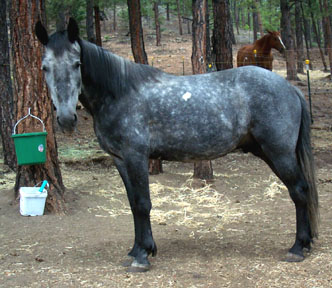
The next photo was taken in December of 2005, just six months after his injury and you can see what a transformed horse he is. He has gone from a horse with muscle tone so poor from lack of activity they felt mushy, to a horse with true buns of steel. Griton will probably always have some slippage in his stifles due to torn ligaments but you only see it now when he is standing still and very relaxed in his muscles. He is the most active 'player' of all of our horses and seldom stands still for long. It's clear his stifle injury will not hold him back in any way and I expect to begin riding him this summer.
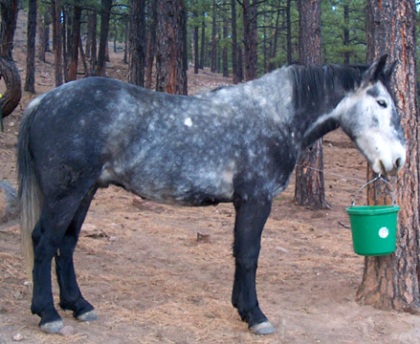
Mustang Mountain
April 26, 2006
My name is Carmon Deyo and my husband Mike Dibble and I live on the side of a mountain in northeastern New Mexico. We have three (soon to be four) formerly wild mustangs who share our lives and who provide us with endless entertainment as they romp and play here.
We became interested in keeping our horses barefoot and natural when we adopted our first mustang in 2002. At the request of the barefoothorsecare list we are starting a journal to record the changes in our horses feet and physical health as we try to provide them with an environment and lifestyle as close as possible to the ones they left in Nevada, Wyoming and New Mexico.